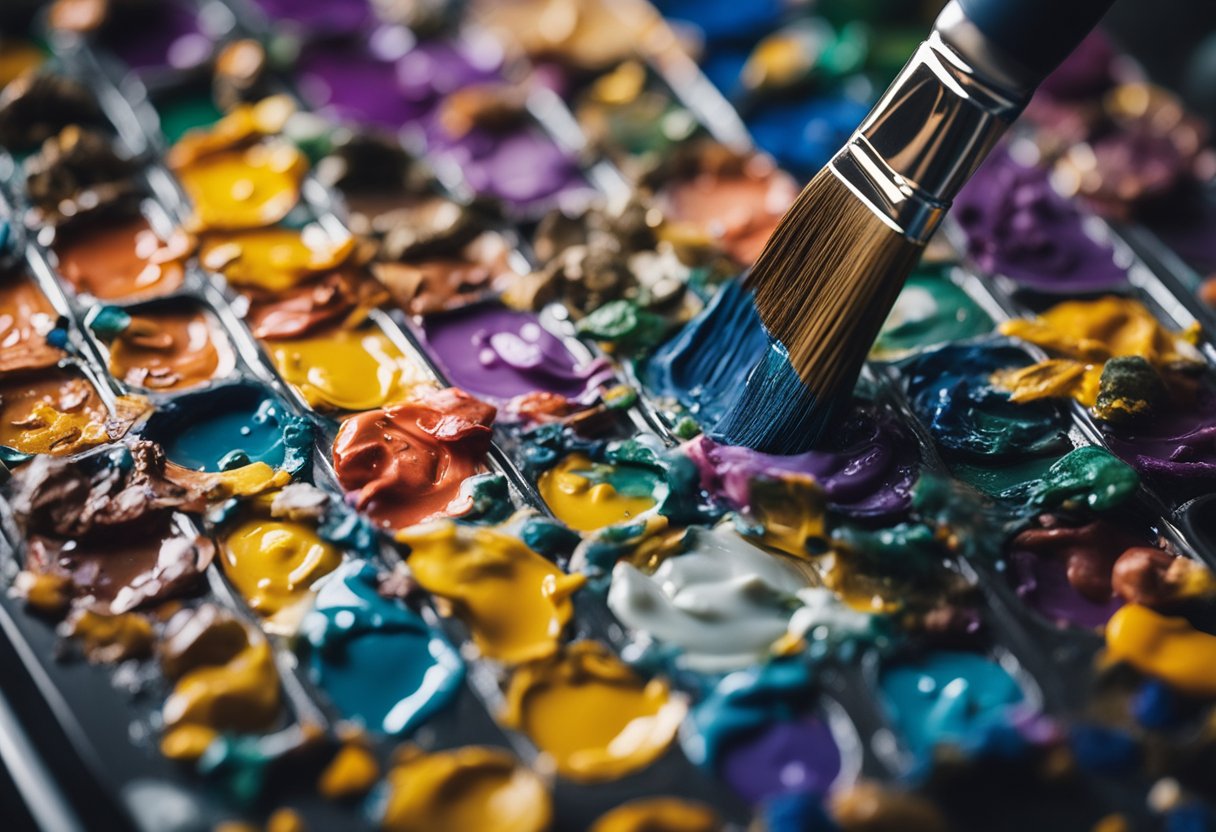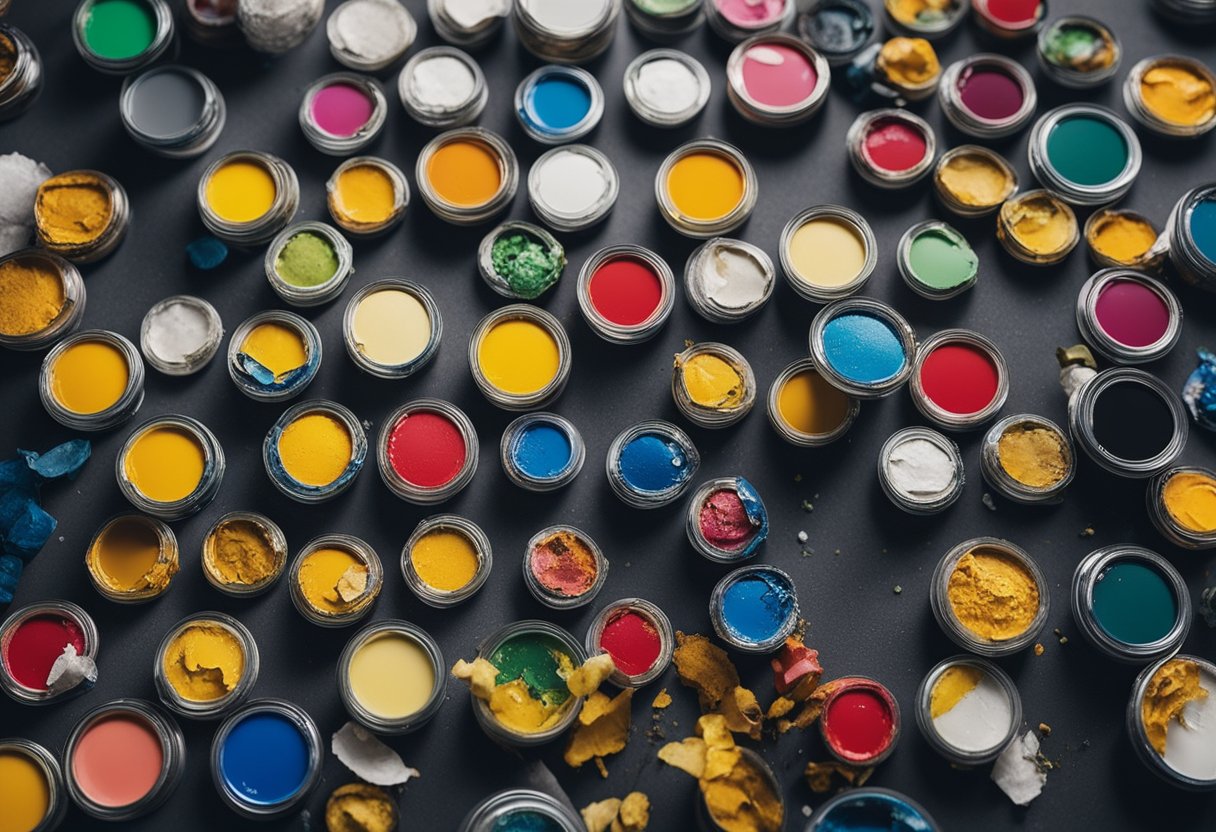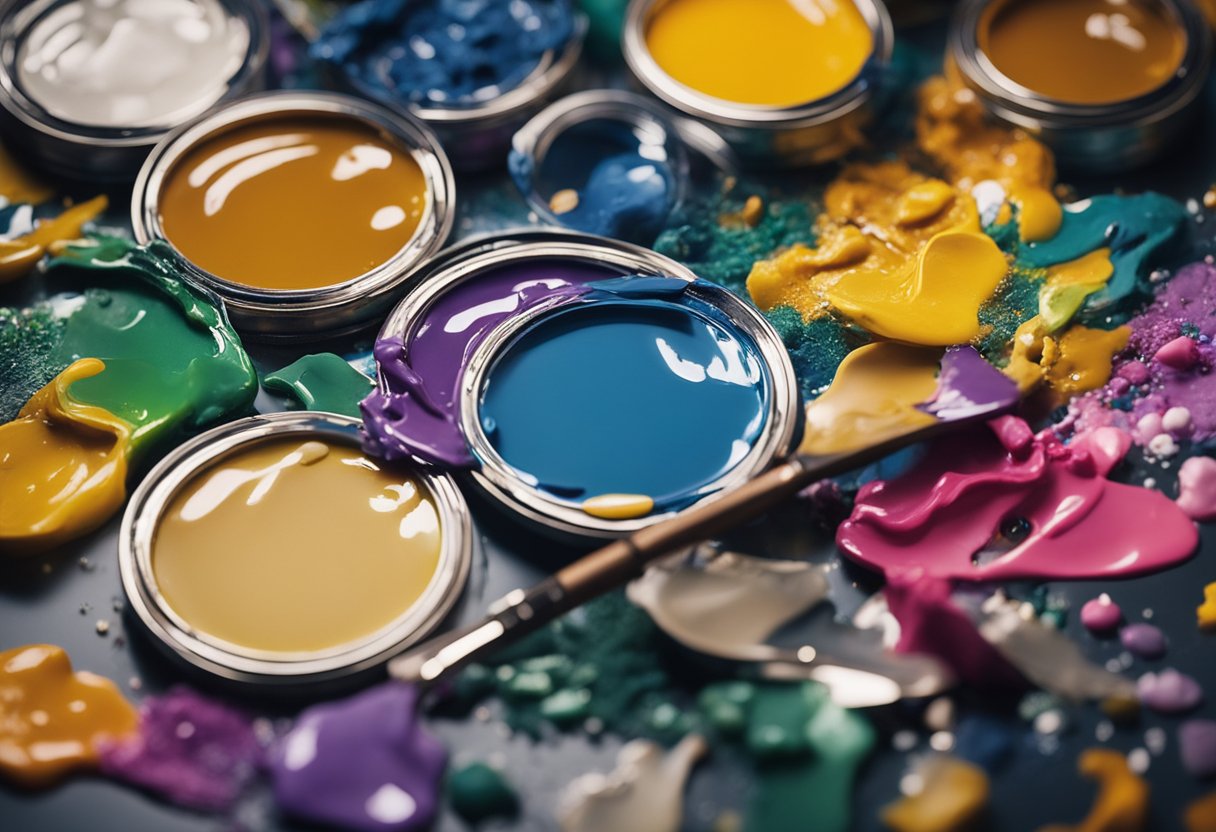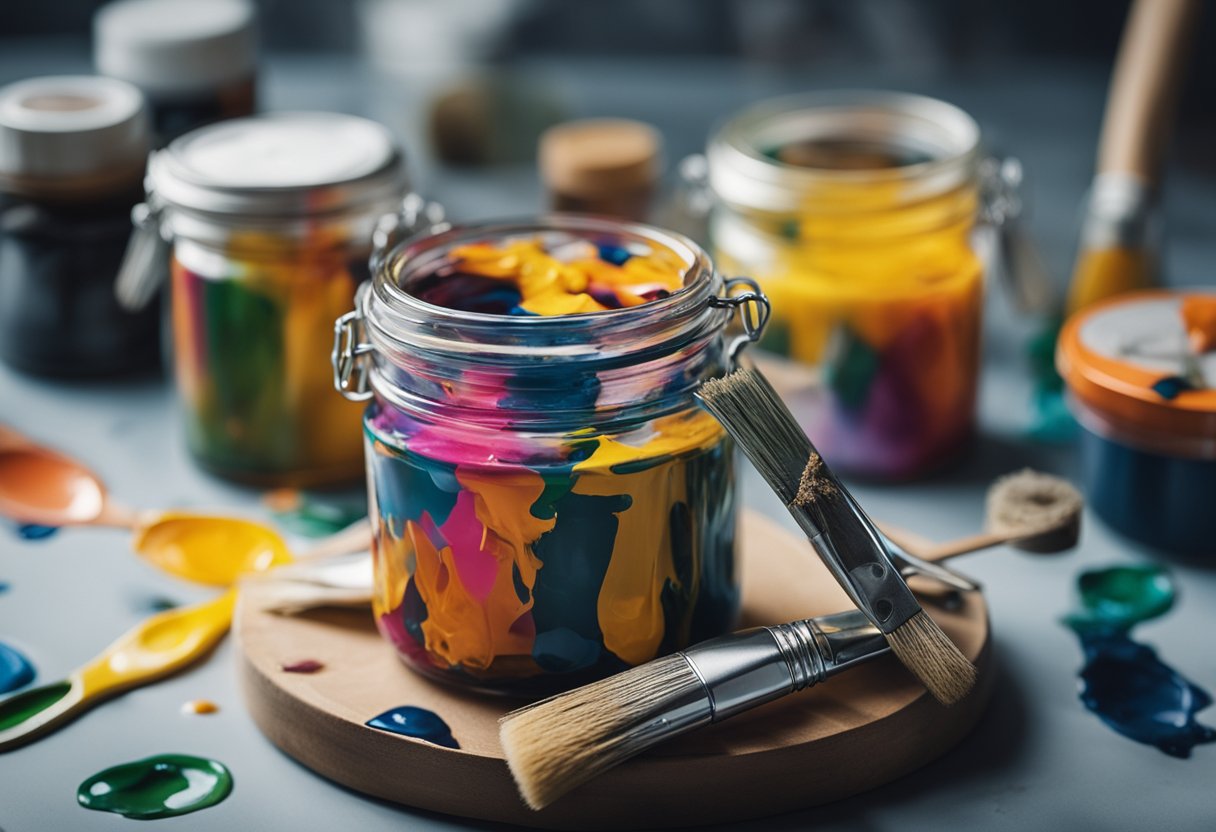Acrylic paint is a popular medium among artists of all levels. It is versatile, easy to use, and dries quickly. However, sometimes acrylic paint can become sticky or tacky after drying, which can be frustrating for artists. In this article, I will explore the reasons why acrylic paint can become sticky after drying and provide solutions to fix the problem.

Understanding acrylic paint is crucial to prevent it from becoming sticky after drying. Acrylic paint is made up of a pigment suspended in an acrylic polymer emulsion. When the paint is applied to a surface, the water in the emulsion evaporates, leaving behind a film of acrylic polymer that binds the pigment to the surface. The film dries quickly, but the paint can take up to a week to fully cure. During this time, the paint can be susceptible to environmental factors that can cause it to become sticky.
Role of environmental factors, such as humidity, temperature, and airflow, can affect the drying process of acrylic paint. High humidity can slow down the drying process and cause the paint to become sticky. Low temperatures can also slow down the drying process, while high temperatures can cause the paint to dry too quickly, trapping moisture inside and causing it to become sticky. Proper ventilation is also important to allow the paint to dry evenly. In the next section, we will explore the drying process of acrylic paint in more detail.
Key Takeaways
- Understanding the drying process of acrylic paint is crucial to prevent it from becoming sticky after drying.
- Environmental factors such as humidity, temperature, and airflow can affect the drying process of acrylic paint.
- Proper ventilation, temperature, and humidity levels are important to allow the paint to dry evenly.
Understanding Acrylic Paint
As an artist, I understand the importance of using the right paint for my artwork. Acrylic paint is one of the most popular types of paint used by artists. It is a water-based paint that dries quickly and is easy to clean up. Acrylic paint is made up of a binder, pigments, and water.
The binder in acrylic paint is a polymer emulsion that holds the pigments together. The pigments are the colorants that give the paint its hue. Acrylic paints come in a wide range of colors and can be mixed to create new colors. The pigments used in high-quality paints are more finely ground and have a higher concentration than those used in low-quality paints.
The quality of the binder and pigments used in the paint affects the quality of the final product. High-quality paints have a higher concentration of pigment and a better binder, which makes them more durable and long-lasting. Good-quality paint is easier to work with and produces better results than low-quality paint.
When using acrylic paint, it is important to use high-quality paint to ensure that the paint dries properly and does not remain sticky after drying. If the paint is too thick or applied in thick layers, it may take longer to dry and can remain sticky. Also, painting in high humidity or extreme temperatures can cause the paint to become sticky.
In summary, understanding the composition and quality of acrylic paint is crucial for artists to create high-quality artwork. Using high-quality paint and applying it correctly can help prevent the paint from remaining sticky after drying.
Role of Environmental Factors

As I have previously mentioned, acrylic paint can become sticky after drying due to several factors. One of the most significant factors is the environment in which the painting is done. Environmental factors such as humidity and temperature can significantly affect the drying process of acrylic paint.
Humidity plays a crucial role in the drying process of acrylic paint. High humidity levels can slow down the drying process and cause the paint to become sticky. It is essential to maintain a controlled humidity level in the painting area to ensure that the paint dries correctly. If the humidity level is too high, the paint may not dry evenly, resulting in a sticky surface.
Temperature is another environmental factor that can affect the drying process of acrylic paint. A dry environment with a stable temperature between 65-75°F is ideal for acrylic paint to dry correctly. If the temperature is too low, the paint may take longer to dry, and if the temperature is too high, the paint may dry too quickly, leading to a cracked or uneven surface.
It is crucial to control the environmental factors when painting with acrylics. A controlled environment with low humidity and stable temperature can help the paint to dry evenly and prevent it from becoming sticky. Using a dehumidifier can help to reduce excess moisture in the air, which can cause the paint to become tacky.
In summary, environmental factors such as humidity and temperature play a crucial role in the drying process of acrylic paint. It is important to maintain a controlled environment when painting with acrylics to ensure that the paint dries evenly and does not become sticky.
Acrylic Paint Drying Process
As an artist who frequently uses acrylic paint, I understand the frustration of having your masterpiece ruined by sticky or tacky paint after it has dried. Understanding the drying process of acrylic paint can help you avoid this issue.
Acrylic paint dries by evaporation of water and solvents from the paint film. The drying time of acrylic paint can vary depending on factors such as humidity, temperature, thickness of paint, and the type of surface it is applied to. On average, acrylic paint will be dry to the touch within 20 to 30 minutes, but this is only the first phase of drying.
The second phase of drying is called the “curing period,” during which the paint fully hardens and becomes more durable. Not allowing enough drying time can result in sticky or tacky paint, as the paint film has not fully cured.
It is important to note that high humidity can also affect the drying process of acrylic paint. High humidity slows down the evaporation process, which can result in longer drying times and potentially sticky paint.
To avoid sticky paint, it is important to allow enough drying time between layers of paint and before varnishing. Applying thick layers of paint can also result in longer drying times and potentially sticky paint. Using a fan or hairdryer to speed up the drying process is not recommended, as it can cause the paint film to dry too quickly on the surface, leaving the paint underneath still wet.
In summary, understanding the drying process of acrylic paint can help you avoid sticky or tacky paint after it has dried. Allowing enough drying time between layers and before varnishing, avoiding thick layers of paint, and avoiding high humidity can all help prevent sticky paint.
Common Issues and Solutions
When working with acrylic paint, it is not uncommon to experience issues with the paint becoming sticky or tacky after drying. This can be frustrating, but fortunately, there are several solutions to this problem.
One common cause of sticky acrylic paint is over-thinning or under-thinning the paint. It is important to follow the manufacturer’s instructions for thinning the paint and to avoid using too much water or medium. If the paint is too thin, it may not dry properly and can become sticky. On the other hand, if the paint is too thick, it may take longer to dry and can also become sticky.
Another factor that can contribute to sticky paint is applying too thick of a layer. It is important to apply thin, even layers of paint and to allow each layer to dry completely before applying another. If the paint is applied too thickly, it may not dry properly and can become sticky or tacky.
High humidity or extreme temperatures can also affect the drying time of acrylic paint and can cause it to become sticky. To prevent this, it is important to work in a well-ventilated area and to use a dehumidifier or air conditioner if necessary. If the paint has already become sticky, using a hairdryer on a low heat setting can help to dry the paint more quickly.
In summary, there are several common causes of sticky acrylic paint, including over-thinning or under-thinning, applying too thick of a layer, and working in high humidity or extreme temperatures. However, by following the manufacturer’s instructions for thinning the paint, applying thin, even layers, and working in a well-ventilated area, it is possible to prevent or fix sticky paint.
Techniques for Proper Application
As an experienced acrylic painter, I have learned that proper application techniques can help prevent sticky paint after drying. Here are some techniques that I use to ensure that my acrylic paint dries smoothly:
Surface Preparation
Before applying acrylic paint, it is important to prepare the painting surface properly. A non-porous surface can cause the paint to remain sticky after drying. To avoid this, I make sure to use a porous surface such as canvas or paper.
Mixing
Mixing the paint properly is crucial to prevent sticky paint. I always use a palette knife to mix the paint thoroughly. Using too much medium or water can cause the paint to become too thin and sticky after drying.
Thin Layers
Applying thin layers of paint can help prevent the paint from becoming sticky after drying. I always apply thin layers of paint and allow each layer to dry completely before applying the next layer.
Too Many Coats of Paint
Applying too many coats of paint can also cause the paint to remain sticky after drying. I always make sure to apply only the necessary number of coats to avoid this issue.
Using Too Much Medium
Using too much medium can also cause the paint to become sticky after drying. I always use the recommended amount of medium and avoid adding too much.
Thick Layers
Applying thick layers of paint can cause the paint to remain sticky after drying. I always make sure to apply thin layers of paint and avoid applying too much paint at once.
By following these techniques, I have been able to prevent sticky acrylic paint after drying. It is important to remember that proper application techniques can make a big difference in the final outcome of your painting.
Enhancing Acrylic Paint Properties
As an artist, I understand how frustrating it can be when the acrylic paint remains sticky even after drying. However, there are several ways to enhance the properties of acrylic paint and avoid this issue.
One way to prevent acrylic paint from becoming sticky is to use a retarder. A retarder is an additive that slows down the drying time of acrylic paint, allowing you to work with it for a longer period. This is particularly useful when working in hot or dry conditions.
Another way to enhance the properties of acrylic paint is by adding an acrylic medium. Acrylic mediums can be used to adjust the gloss, matte, or glossy finish of the paint. Additionally, they can be used to add texture to the paint, making it more interesting and dynamic.
When sanding acrylic paint, it is important to use fine-grit sandpaper to avoid damaging the surface. Sanding can be used to smooth out rough patches or to create a more textured surface. It is also important to use a filler to fill any gaps or holes in the surface before painting.
To protect your acrylic paint from damage, it is important to apply a varnish or spray paint. Varnish can be used to protect the surface of the paint from UV damage, scratches, and other types of damage. Spray paint can be used to add a layer of protection to the paint, making it more durable and long-lasting.
In conclusion, there are several ways to enhance the properties of acrylic paint and avoid issues such as stickiness. By using retarders, acrylic mediums, sandpaper, fillers, and varnish, you can create a beautiful and long-lasting work of art.
Role of Additives and Preparation

When it comes to acrylic paint, the role of additives and preparation cannot be overstated. Proper preparation of the surface to be painted is essential to ensure good adhesion and prevent the paint from becoming sticky after drying. This includes cleaning the surface thoroughly to remove any dust, dirt, or grease, as well as priming the surface if necessary.
In addition to surface preparation, the use of additives can also help to prevent acrylic paint from becoming sticky after drying. Additives such as flow improvers, paint thinners, and retarders can be used to improve the flow of the paint, reduce the drying time, and prevent the paint from becoming too thick and sticky. However, it is important to use compatible additives and not to add too much water, as this can cause the paint to become too thin and lose its adhesive properties.
Proper ventilation is also important when working with acrylic paint, as it can help to prevent the paint from becoming sticky after drying. Good ventilation can help to reduce the humidity in the air, which can slow down the drying time of the paint and cause it to become sticky. It is also important to work in a clean and dust-free environment, as dust and debris can stick to the paint and cause it to become bumpy and uneven.
In summary, the role of additives and preparation is crucial when working with acrylic paint. Proper preparation of the surface to be painted, the use of compatible additives, and good ventilation can all help to prevent the paint from becoming sticky after drying. By taking these steps, you can ensure that your acrylic paintings will have a smooth and even finish that will last for years to come.
Frequently Asked Questions

How to fix acrylic paint that remains sticky after drying?
If your acrylic paint is still sticky after drying, there are a few things you can do to fix it. First, try letting it dry for a longer period of time. If the problem persists, consider adding a layer of varnish to seal the paint and prevent it from remaining tacky. Another option is to use a paint thinner to remove the sticky layer and allow the paint to dry properly.
Why is my acrylic paint sticky after drying?
There are several reasons why acrylic paint can become sticky after drying. One possible cause is over-thinning or under-thinning the paint. Other reasons include not allowing enough time for each layer to dry, improper mixing, using low-quality materials or expired paints, painting in high humidity or extreme temperatures, and applying too thick of a layer.
How to make acrylic paint not sticky?
To prevent acrylic paint from remaining sticky after drying, make sure to use high-quality materials and avoid over-thinning or under-thinning the paint. Allow each layer to dry completely before applying another layer, and make sure to mix the paint thoroughly before using it. Additionally, avoid painting in high humidity or extreme temperatures, and apply thin layers of paint instead of thick layers.
Will tacky acrylic paint eventually dry?
In most cases, tacky acrylic paint will eventually dry. However, it may take longer than usual, and the paint may not dry evenly or may crack or peel once it does dry. To avoid these issues, it is best to take steps to prevent the paint from becoming tacky in the first place.
How to fix sticky acrylic paint on canvas?
To fix sticky acrylic paint on canvas, try using a paint thinner to remove the sticky layer and allow the paint to dry properly. Alternatively, you can add a layer of varnish to seal the paint and prevent it from remaining tacky.
How to fix sticky acrylic paint on plastic?
To fix sticky acrylic paint on plastic, try using a paint thinner to remove the sticky layer and allow the paint to dry properly. Alternatively, you can add a layer of varnish to seal the paint and prevent it from remaining tacky.

Hi, I’m Sal Muller of Tooltrip.com. My DIY experience led me to understand essential power tools for home projects. Tooltrip.com guides enthusiasts and professionals in choosing right tools for any job. I provide concise top tool reviews for easier, efficient DIY.

